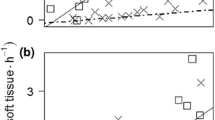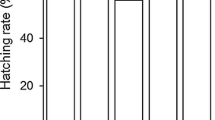Abstract
The golden apple snail (Pomacea maculata Perry) is an invasive species that lays its eggs out of water but is otherwise aquatic. To investigate this behavior and potential management techniques, we conducted experiments to examine the physical effects of immersion and underwater egg predation on hatching success. Predation on submerged eggs by P. maculata adults reduced hatching success by ∼99%. In predator-free conditions, hatching success was reduced 75% by immersion in water and was negatively correlated with time submerged. Our results suggest that both underwater egg predation and low immersion tolerance may be exploited to limit the spread of P. maculata.
Similar content being viewed by others
Literature Cited
Aditya, G. and S. K. Raut. 2001. Food of the snail, Pomacea bridgesi, introduced in India. Current Science 80: 919–21.
Aditya, G. and S. K. Raut. 2005. Feeding of the leech Glossiphonia weberi on the introduced snail Pomacea bridgesii in India. Aquatic Ecology 39: 465–71.
Albrecht, E. A., N. B. Carreno, and A. Castro Vaszquez. 1996. A quantitative study of copulation and spawning in the South American apple-snail, Pomacea canaliculata (Prosobranchia: Ampullariidae). Veliger 39: 142–47.
Baker, G. H. 1998. The golden apple snail, Pomacea canaliculata (Lamarck) (Mollusca: Ampullariidae), a potential invader of fresh water habitats in Australia. In: Pest Management — Future Challenges. Sixth Australian Applied Entomological Research Conference 2:21-46. The University of Queensland, Brisbane, Australia.
Bruton, M. N. 1995. Have fishes had their chips — the dilemma of threatened fishes. Environmental Biology of Fishes 43: 1–27.
Buchan, L. A. J. and D. K. Padilla. 1999. Estimating the probability of long-distance overland dispersal of invading aquatic species. Ecological Applications 9: 254–65.
Canonico, G. C., A. Arthington, J. K. McCrary, and M. L. Thieme. 2005. The effects of introduced tilapias on native biodiversity. Aquatic Conservation — Marine and Freshwater Ecosystems 15: 463–83.
Carlsson, N. O. L., C. Brönmark, and L.-A. Hansson. 2004a. Invading herbivory: the golden apple snail alters ecosystem functioning in Asian wetlands. Ecology 85: 1575–80.
Carlsson, N., A. Kestrup, M. Martensson, and P. Nystrom. 2004b. Lethal and non-lethal effects of multiple indigenous predators on the invasive golden apple snail (Pomacea canaliculata). Freshwater Biology 49: 1269–79.
Carlsson, N. O. L. and J. O. Lacoursière. 2005. Herbivory on aquatic vascular plants by the introduced golden apple snail (Pomacea canaliculata) in Lao PDR. Biological Invasions 7: 233–41.
Claessen, D., A. M. deRoos, and L. Persson. 2004. Population dynamic theory of size-dependent cannibalism. Proceedings of the Royal Society of London Series B-Biological Sciences 271: 333–40.
Courchamp, F., J. L. Chapuis, and M. Pascal. 2003. Mammal invaders on islands: impact, control and control impact. Biological Reviews 78: 347–83.
Cowie, R. H. and S. C. Thiengo. 2003. The apple snails of the Americas (Mollusca: Gastropoda: Ampullariidae: Asolene, Felipponea, Marisa, Pomacea, Pomella): a nomenclature and type catalog. Malacologia 45: 41–100.
Estebenet, A. L. and P. R. Martin. 2002. Pomacea canaliculata (Gastropoda: Ampullariidae): life-history Traits and their Plasticity. Biocell 26: 83–89.
Fujio, Y., M. Nakajima, and H. Showa. 1997. Selection and inbreeding depression in maintenance of a stock population of the apple snail Pomacea canaliculata. Fisheries Science 63: 368–71.
Halwart, M. 1994. The golden apple snail Pomacea canaliculata in Asian rice farming systems: present impact and future threat. International Journal of Pest Management 40: 199–206.
Henderson, S., T. P. Dawson, and R. J. Whittaker. 2006. Progress in invasive plants research. Progress in Physical Geography 30: 25–46.
Howells, R. G. 2005. Invasive applesnails in Texas: status of these harmful snails through spring 2005. Texas Department of Wildlife, Heart of the Hills Fisheries Science Center, Ingram, TX, USA.
Ichinose, K. and M. Tochihara. 2003. Increased per-capita investment in egg production by female apple snails in the presence of common carp. Behaviour 140: 935–45.
Ito, K. 2002. Environmental factors influencing overwintering success of the golden apple snail, Pomacea canaliculata (Gastropoda: Ampullariidae), in the northernmost population in Japan. Applied Entomology and Zoology 37: 655–61.
Lever, C. 2001. The Cane Toad: The History and Ecology of a Successful Colonist. Westbury Academic and Scientific Publishing, Otley, UK.
Levin, L. A., C. Neira, and E. D. Grosholz. 2006. Invasive cordgrass modifies wetland trophic function. Ecology 87: 419–32.
McCabe, D. J., M. A. Beekey, A. Mazloff, and J. E. Marsden. 2006. Negative effect of zebra mussels on foraging and habitat use by lake sturgeon (Acipenser fulvescens). Aquatic Conservation — Marine and Freshwater Ecosystems 16: 493–500.
McChesney, G. J. and B. R. Tershy. 1998. History and status of introducing mammals and impacts to breeding seabirds on the California channel and northwestern Baja California islands. Colonial Waterbirds 21: 335–47.
Naylor, R. 1996. Invasions in agriculture: assessing the cost of the golden apple snail in Asia. Ambio 25: 443–48.
Pimentel, D., S. McNair, J. Janecka, J. Wightman, C. Simmonds, C. O’Connell, E. Wong, L. Russel, J. Zern, T. Aquino, and T. Tsomondo. 2001. Economic and environmental threats of alien plant, animal, and microbe invasions. Agriculture Ecosystems and Environment 84: 1–20.
Pizani, N. V., A. L. Estebenet, and P. R. Martin. 2005. Effects of submersion and aerial exposure on clutches and hatchlings of Pomacea canaliculata (Gastropoda: Ampullariidae). American Malacological Bulletin 20: 55–63.
Simpson, S. J., G. A. Sword, P. D. Lorch, and I. D. Couzin. 2006. Cannibal crickets on a forced march for protein and salt. Proceedings of the National Academy of Sciences of the United States of America 103: 4152–56.
Snyder, N. F. R. and H. A. Snyder. 1971. Defenses of the Florida apple snail Pomacea paludosa. Behaviour 40: 175–215.
Stevens, A. J., N. M. Stevens, P. C. Darby, and H. F. Percival. 1999. Observations of fire ants (Solenopsis invicta Buren) attacking apple snails (Pomacea paludosa Say) exposed during dry down conditions. Journal of Molluscan Studies 65: 507–10.
Teo, S. S. 2001. Evaluation of different duck varieties for the control of the golden apple snail (Pomacea canaliculata) in transplanted and direct seeded rice. Crop Protection 20: 599–604.
Turner, R. L. 1998. Effects of submergence on embryonic survival and developmental rate of the Florida applesnail, Pomacea paludosa: implications for egg predation and marsh management. Florida Scientist 61: 118–29.
Yusa, Y. 2001. Predation on eggs of the apple snail Pomacea canaliculata (Gastropoda: Ampullariidae) by the fire ant Solenopsis geminata. Journal of Molluscan Studies 67: 275–79.
Yusa, Y., N. Sugiura, and K. Ichinose. 2000. Predation on the apple snail, Pomacea canaliculata (Ampullaridae), by the Norway rat, Rattus norvegicus, in the field. Veliger 43: 349–53.
Yusa, Y., N. Sugiura, and T. Wada. 2006. Predatory potential of freshwater animals on an invasive agricultural pest, the apple snail Pomacea canaliculata (Gastropoda: Ampullariidae), in southern Japan. Biological Invasions 8: 137–47.
Yusa, Y. and T. Wada. 1999. Impact of the introduction of apple snails and their control in Japan. Naga, the ICLARM Quarterly 22: 9–13.
Author information
Authors and Affiliations
Corresponding author
Rights and permissions
About this article
Cite this article
Horn, K.C., Johnson, S.D., Boles, K.M. et al. Factors affecting hatching success of golden apple snail eggs: Effects of water immersion and cannibalism. Wetlands 28, 544–549 (2008). https://doi.org/10.1672/07-11.1
Received:
Accepted:
Issue Date:
DOI: https://doi.org/10.1672/07-11.1




